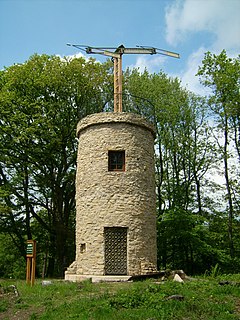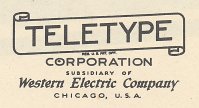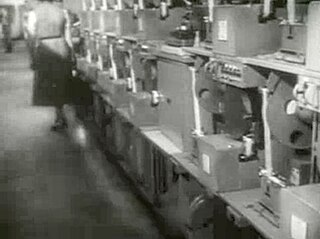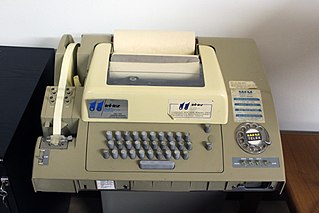
The Baudot code[boˈdo] is an early character encoding for telegraphy invented by Émile Baudot in the 1870s. It was the predecessor to the International Telegraph Alphabet No. 2 (ITA2), the most common teleprinter code in use until the advent of ASCII. Each character in the alphabet is represented by a series of five bits, sent over a communication channel such as a telegraph wire or a radio signal. The symbol rate measurement is known as baud, and is derived from the same name.

An electrical telegraph is a point-to-point text messaging system, primarily used from the 1840s until the mid 20th century when it was slowly replaced by other telecommunication systems. It used coded pulses of electric current through dedicated wires to transmit information over long distances. It was the first electrical telecommunications system, the most widely used of a number of early messaging systems called telegraphs, devised to send text messages more rapidly than written messages could be sent. This system allowed for communication to occur without the necessity of physical transportation. Prior to the electric telegraph, semaphore systems were used, including beacons, smoke signals, flag semaphore, and optical telegraphs for visual signals to communicate over distances of land.

Jean-Maurice-Émile Baudot, French telegraph engineer and inventor of the first means of digital communication Baudot code, was one of the pioneers of telecommunications. He invented a multiplexed printing telegraph system that used his code and allowed multiple transmissions over a single line. The baud unit was named after him.

Radioteletype (RTTY) is a telecommunications system consisting originally of two or more electromechanical teleprinters in different locations connected by radio rather than a wired link. These machines were superseded by personal computers (PCs) running software to emulate teleprinters. Radioteletype evolved from earlier landline teleprinter operations that began in the mid-1800s. The US Navy Department successfully tested printing telegraphy between an airplane and ground radio station in 1922. Later that year, the Radio Corporation of America successfully tested printing telegraphy via their Chatham, Massachusetts, radio station to the R.M.S. Majestic. Commercial RTTY systems were in active service between San Francisco and Honolulu as early as April 1932 and between San Francisco and New York City by 1934. The US military used radioteletype in the 1930s and expanded this usage during World War II. From the 1980s, teleprinters were replaced by computers running teleprinter emulation software.

Telegraphy is the long-distance transmission of textual messages where the sender uses a semaphore system, known to the recipient, rather than a physical exchange of an object bearing the message. Thus flag semaphore is a method of telegraphy, whereas pigeon post is not. Ancient signalling systems, although sometimes quite extensive and sophisticated as in China, were generally not capable of transmitting arbitrary text messages. Possible messages were fixed and predetermined and such systems are thus not true telegraphs.

A teleprinter is an electromechanical device that can be used to send and receive typed messages through various communications channels, in both point-to-point and point-to-multipoint configurations. Initially they were used in telegraphy, which developed in the late 1830s and 1840s as the first use of electrical engineering, though teleprinters were not used for telegraphy until 1887 at the earliest. The machines were adapted to provide a user interface to early mainframe computers and minicomputers, sending typed data to the computer and printing the response. Some models could also be used to create punched tape for data storage and to read back such tape for local printing or transmission.

Punched tape or perforated paper tape is a form of data storage that consists of a long strip of paper in which holes are punched. It developed from and was subsequently used alongside punched cards, differing in that the tape is continuous.

Ticker tape was the earliest electrical dedicated financial communications medium, transmitting stock price information over telegraph lines, in use from around 1870 through 1970. It consisted of a paper strip that ran through a machine called a stock ticker, which printed abbreviated company names as alphabetic symbols followed by numeric stock transaction price and volume information. The term "ticker" came from the sound made by the machine as it printed.
A telegraph code is one of the character encodings used to transmit information by telegraphy. Morse code is the best-known such code. Telegraphy usually refers to the electrical telegraph, but telegraph systems using the optical telegraph were in use before that. A code consists of a number of code points, each corresponding to a letter of the alphabet, a numeral, or some other character. In codes intended for machines rather than humans, code points for control characters, such as carriage return, are required to control the operation of the mechanism. Each code point is made up of a number of elements arranged in a unique way for that character. There are usually two types of element, but more element types were employed in some codes not intended for machines. For instance, American Morse code had about five elements, rather than the two of International Morse Code.

The Friden Flexowriter was a teleprinter, a heavy-duty electric typewriter capable of being driven not only by a human typing, but also automatically by several methods, including direct attachment to a computer and by use of paper tape.

The Teletype Model 33 is an electromechanical teleprinter designed for light-duty office use. It is less rugged and cost less than earlier Teletype machines. The Teletype Corporation introduced the Model 33 as a commercial product in 1963 after being originally designed for the United States Navy. There are three versions of the Model 33:
Frederick George Creed was a Canadian inventor, who spent most of his adult life in Britain. He worked in the field of telecommunications, and is particularly remembered as a key figure in the development of the teleprinter. He also played an early role in the development of SWATH vessels.
KDF8 was an early British computer built by English Electric as a version of the RCA 501. By producing a software-compatible system, the intention was to reduce time and cost to develop software. However, the lengthy process of developing manufacturing capability meant that the system was soon outpaced by systems from other vendors. Only a few systems were sold during its 5 years of production. Due to the consolidation of the British computer industry, English Electric's computer division became one of the components of what would become ICL.

The Teletype Corporation, a part of American Telephone and Telegraph Company's Western Electric manufacturing arm since 1930, came into being in 1928 when the Morkrum-Kleinschmidt Company changed its name to the name of its trademark equipment. Teletype Corporation, of Skokie, Illinois, was responsible for the research, development and manufacture of data and record communications equipment, but it is primarily remembered for the manufacture of electromechanical teleprinters.
Edward Ernst Kleinschmidt was one of the inventors of the teleprinter, and was a prolific inventor who obtained 118 patents in the course of his 101-year life.

Plan 55-A was one in a series of store and forward message switching systems developed by Western Union and used from 1948 to 1976 for processing telegrams. It is an automated successor to Plan 51, which commenced service in 1951 in a nationwide network of the U.S. Air Force, but required semi-automatic operation.

The telex network was a customer-to-customer switched network of teleprinters similar to a telephone network, using telegraph-grade connecting circuits for two-way text-based messages. Telex was a major method of sending written messages electronically between businesses in the post-World War II period. Its usage went into decline as the fax machine grew in popularity in the 1980s.
C. Lorenz AG (1880-1958) was a German electrical and electronics firm primarily located in Berlin. It innovated, developed and marketed products for electric lighting, telegraphy, telephony, radar, and radio. It was acquired by ITT in 1930, and became part of the newly founded company Standard Elektrik Lorenz (SEL), Stuttgart in 1958 when it merged with Standard Elektrizitätsgesellschaft and several other smaller companies owned by ITT. In 1987, SEL merged with the French companies Compagnie Générale d'Electricité and Alcatel to form the new Alcatel SEL.

Donald Murray was an electrical engineer and the inventor of a telegraphic typewriter system using an extended Baudot code that was a direct ancestor of the teleprinter. He can justifiably be called the "Father of the remote Typewriter".
The Teletype Model 28 is a product line of page printers, typing and non-typing tape perforator and tape reperforators, fixed head single contact and pivoted head multi-contact transmitter-distributors, and receiving selector equipment. Regarded as the most rugged machines Teletype Corporation built, this line of teleprinters used an exchangeable type box for printing and sequential selector "Stunt Box" to mechanically initiate non-printing functions within the typing unit of the page printer, electrically control functions within the page printer and electrically control external equipment.

















